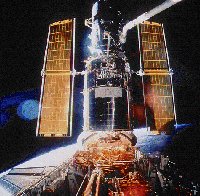|
The
Hubble Space Telescope
The
@stro object for the week of 03/20/2000

image
courtesy of STSCI
The Hubble
Space Telescope. The
Hubble Space Telescope, commonly referred to as the "HST",
is named for Edwin Hubble (1889-1953) who is credited with making
ground breaking discoveries in astronomy such as the discovery of
redshift. The HST
was placed into low-Earth orbit by the Space
Shuttle in 1990 and without
a doubt the Hubble Space Telescope continues to be one of the most
powerful astronomical research tools in existence today.
When it was
first launched the HST suffered from "spherical aberration"
in its primary mirror but a Shuttle servicing mission in 1993 installed
corrective optics that alleviated this problem. Since this correction
the HST has continued to function and return incredible pictures
recognized by the public worldwide. It has also been the recipient
of more servicing missions since that 1993 mission, the last one
occurring in 1999.
The HST utilizes
multiple imaging instruments. Among the most notable is the Wide
Field/Planetary Camera 2 (WFPC2) from which incredible views have
resulted. These celestial sites include such wonders as star formation
in the Trifid Nebula, to viewing the
rings around Saturn, to spying on the wispy gas clouds in the Reflection
Nebula, to providing our first images ever of a cometary impact
on another planet when Comet Shoemaker-Levy 9 slammed into Jupiter
.
Hubble is getting
its own stamp in the US Postal Service's "Space Achievement
and Exploration" stamp set this year. The HST is part of NASA's
Great Observatories program (see also Chandra
X-Ray Telescope) and is expected to continue operation through
2010.
| Current
information for the Hubble Space Telescope: |
| Aperture:
2.4 meters |
| Focal Length
(without correction): f/24 |
| Mission
Launched: April 25, 1990 |
| Expected
Mission Duration: 20 years |
more
info from STSCI...
go
straight to the pictures...
find
out where the HST is now (online Java app)...
check
out the stamp design...
|